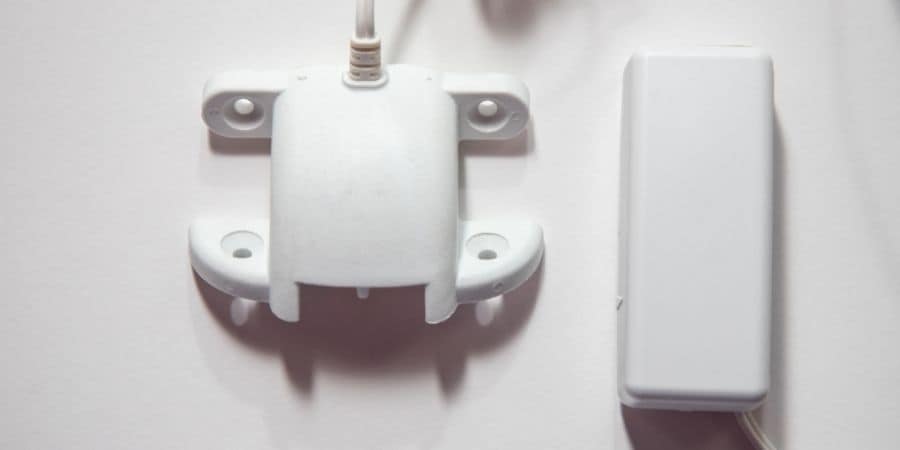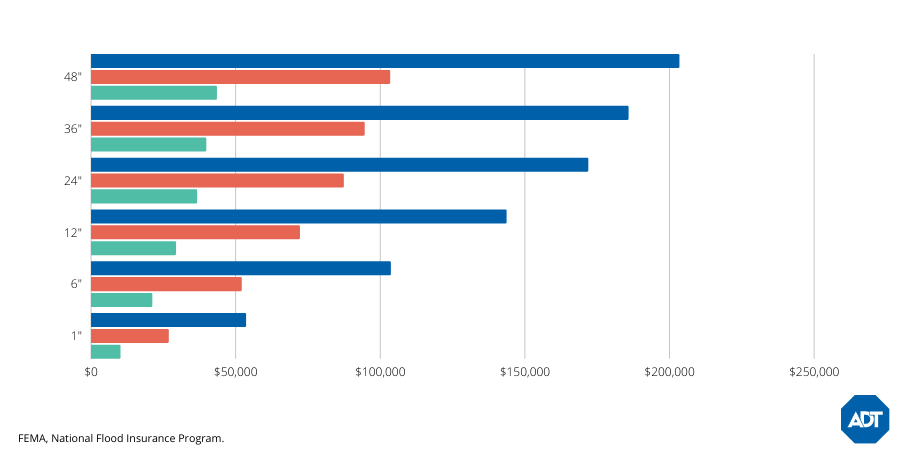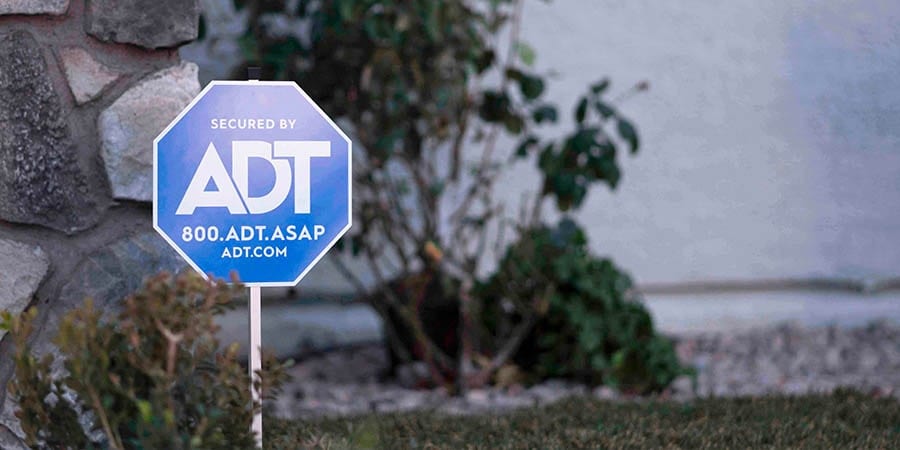Every year, water problems account for millions of dollars in damage. And while significant floods happen in certain areas every year, a broken pipe or leaky faucet can occur in any home.
Even small leaks have the potential to cause massive damages, so it’s crucial to not only be proactive before a leak occurs but also to have a plan in place if one does happen.
This article discusses what a water leak sensor is and how it differs from a water leak detection system. We'll also leave you with some tips on how you can help prevent flooding in your home--some of them so simple you can do them today.
What is a water leak detector, and how does it work?
Water detectors come in different types: a complete water system with a shutoff valve that turns off your water once it senses a leak and portable water sensors that detect a leak as it’s happening.
Both systems detect water but vary in how they handle leaks or floods. Leak detection systems interrupt the physical flow of water. They can often be costly, requiring a plumber to install the system or know-how for self-installation.
Ultimately, these leak alerts come in three types:
A professionally installed leak detection system that is attached directly to the waterline. It not only monitors the flow of water but can also turn it off.
A DIY-installed leak detection system that uses a motor. It opens and closes the water valve if leaking water is sensed and often requires some technical knowledge.
A flood sensor is much less complicated. You set a water sensor up where a leak may occur, notifying you when it senses moisture or water.
Where should you put a water leak sensor?
You should put a water alarm anywhere prone to flooding or where leaks might occur.
Specifically, we suggest you place them in these locations:
Near the washing machine. Place a sensor underneath or next to it, in case your washing machine gets a cracked hose or overflows during a cycle.
In the basement, where floodwaters often reach first. It's a good idea to add sensors underneath pipes or windows where leaks may also occur.
In the bathroom, next to the toilet, or underneath the sink to catch any clogs or water leaks from burst pipes.
Inside a garage, on either side of the garage to sense any leaks from flooding.
Under the fridge, where leaks are most susceptible, so you can get alerted to leaks before water damage occurs.
At the base of a water heater. Sometimes old water heaters break down and leak, but placing a sensor here could help you catch the leak and repair the appliance.
In the kitchen, under the sink, and next to the dishwasher. By placing sensors in these areas, you're more likely to get wind of a leak early.
Inside the attic. Place sensors along the windows and eaves to catch any leaks from storms.
Or, don’t even worry about where to install with ADT. Our security pros find the proper placement for you.

Water leak statistics and facts:
Water leak sensors help monitor moisture levels and water, helping you find water leaks before they become more serious.
Every day around fourteen thousand people in the U.S. experience a water damage emergency.
Floods are one of the most common natural disasters in the United States since about 90% of natural disasters involve them.
Floods happen in every state and kill more people every year than lightning, hurricanes, and tornadoes [1].
The construction of buildings, highways, driveways, and parking lots increases runoff by reducing the amount of rain absorbed by the ground [1].
Since flooding can happen anywhere, it’s important to be aware of your local flood map and plan accordingly.
Just a few inches of water can cause over $10,000 of damage.
$2.4 billion is lost in floods annually [2].
According to the National Flood Insurance Program, $52,000 is the average flood claim payout.
High-risk zones have a 26% chance of being damaged by floods during your 30-year mortgage versus a 10% chance of being damaged by fire.
30% of flood insurance claims are from low-to moderate-risk areas [2].
Flood Damage Cost Estimates

What are some common causes of home flooding?
Floods often happen during periods of heavy rains, when the soil is so saturated that the runoff has nowhere to go. Prolonged rains are the most common occurrence of floods and vary in severity.
We’ve compiled a list of some of the most common causes of home flooding, with some tips and suggestions on how to help prepare your home against these potential issues.
Flash flooding or heavy rainfall
Some places are just more prone to risky weather situations. Keep an eye on changing weather patterns so that you can prepare your home for the rainy season. Installing a flood sensor, buying flood insurance, assuming good landscaping practices, and waterproofing your basement help prepare your property for significant rain events.Broken pipes
It can take mere moments for a burst pipe to cause damage in a basement. Check your lines regularly to ensure they aren't leaking, and immediately patch any leaks you find. Sometimes extreme temperature changes can freeze and swell old pipes, so you should take special considerations in older homes.Foundations
Your home should be on a sturdy cement foundation. Faulty or cracked foundations allow water or melting ice to seep into the floors, which could eventually cause flooding or water damage.Clogged gutters or drainage issues
If your gutters get clogged, water doesn't have anywhere to go. It could pool along outside of your home or seep into your foundation, causing damage along the way.Malfunctioning appliances
Many appliances in your home use water, including your washing machine, dishwasher, and refrigerator. If these items are improperly installed or have faulty connections, they're more likely to experience issues with water leaking. You should inspect the connections regularly for toilet leaks or other plumbing leaks and replace or repair any faulty connections you see.
How can you prevent home floods?
You can do things to lessen your risk and help reduce flood damage both inside your home and your property.
FEMA suggests three key steps to consider when creating an initial plan of action:
Know your flood risk for the area where you live.
Ensure your property since typical homeowners’ insurance doesn’t protect against flood damage.
Reduce your risk based on your home's individual needs. Creating a flood plan goes a long way towards ensuring the safety of your property.
Doing a simple few home projects can go a long way towards helping prevent flooding and keep your property maintained.
Avoid planting trees too close to the foundation. A good rule of thumb is to plant them about 10-20 feet away. As plants grow, their root systems may damage your foundation or obstruct flood drainage.
Keep gutters clear of debris. If they appear clogged, it's time to clean them. Create a seasonal cleaning routine to prevent buildup and clean out gutters twice a year.
Make sure your service equipment is elevated. Raise service equipment at least one foot above the possible flood area to prevent flood damage to these expensive items.
Install additional water run-offs, like grates or a rain barrel. Rain barrels often connect to your gutters, allowing water to collect inside the canisters instead of pooling on the ground. You can later recycle this water in your garden or clean your car with it.
Anchor fuel tanks to a concrete slab or mount ground anchors if you live in an area prone to intense flooding. You should also elevate these tanks if you live in a high-risk area or raise the filing and ventilation tubes. This helps prevent the fuel tank from being carried away or rupturing from floodwaters.
Maintaining the inside of your home and knowing where potential leaks originate can also help keep your home dry.
Repair any leaks or cracks immediately. Be on the lookout for wet spots on the ceiling or if there's pooling water or water stains somewhere in your home. Check your pipes for water damage, rust, or buckling and fix these issues if they come up.
Install flood vents to allow water to flow out, depositing the water outside of any away from your home.
Basements can become a source of flooding if there are leaky pipes or if the surrounding foundation has too much water and doesn't have a proper way to drain. We've compiled some tips to help prep your basement against excess moisture.
Consider installing a sump pump in the basement. It works by funneling water towards the pump and draining it into a nearby storm drain, keeping water from collecting in the basement. When choosing a sump pump, consider purchasing a battery-operated one if your home loses power.
.Add a backflow valve to your basement. Sometimes when heavy rains happen, sewer lines may get backed up, causing water or sewage to drift back into your home. The backflow valve prevents this from happening.
Seal the basement. Use caulk or other waterproofing materials around cracks in the basement foundation to fill any gaps to avoid leaks.
[Source]
What to do if your house floods?
Since flooding can happen anywhere, you should have a plan in place if your home floods and you need to evacuate immediately.
If possible, turn the water off at its source, or turn off the main water valve.
If you can safely flip the breaker to turn off the electricity, you should do so.
Evacuate your home.
If the flooding is severe enough, call for help.
Document the damage, then call your landlord or homeowner’s insurance.
Whether flooding happens because of a burst pipe or a natural disaster, you must remain calm and try to get to safe ground with your family and pets as soon as possible, no matter where the source of the leak is.

Find out how ADT can help protect your home from flooding.
Flood sensors are an essential part of every complete home security system, and when used with door and window sensors, cameras, and CO and fire detectors, they help give you peace of mind.
Call ADT today to help protect your home from floods, intruders, and more.
Frequently Asked Questions about Water Leak Detectors
What are some signs of a water leak?
Some signs of a water leak include an unusually high water bill for several months, increased signs of mold or mildew on the walls or ceilings, a sudden lack of water pressure, or standing pools of water, or unusual stains where pipes are present.
How do ADT water leak detectors work with ADT control?
Once ADT's flood detector sensors detect a leak, you receive a notification to your smartphone. Add a sensor to your current ADT plan and get 24/7 flood monitoring, professional monitoring, and peace of mind.
How does a water leak detector work?
These devices recognize a potential leak and automatically stop the water using leak detection technology.
On the other hand, leak sensors are moveable devices that you put where moisture is expected, like under a bathroom sink. Once the water sensor is engaged, it triggers an audible alarm that notifies you of a potential leak.
Related Articles:


